When it comes to colorful ducks, males (drakes) are often more vibrant than females (hens), especially during the breeding season. Here are 15 of the most colorful wild ducks from around the world, all of them breeding season males decked out in their best and brightest colors!
1. African Pgymy-Goose (Nettapus auritus)

The African pygmy-goose is a perching duck species.
©Bernard DUPONT from FRANCE / CC BY-SA 2.0 - Original / License
African pygmy-geese are native to continental Africa and Madagascar (and despite the common name, are in fact ducks and not geese), and is the smallest waterfowl in its range. The breeding season male has a white face, neck, and belly; green patch on the side of the head; black crown, nape, and upperparts with green iridescence; and pale chestnut lower neck, breast, and flanks. The male also has a bright yellow bill with black nail, reddish-brown eyes, and dark gray legs and feet.
2. Baikal Teal (Sibirionetta formosa)
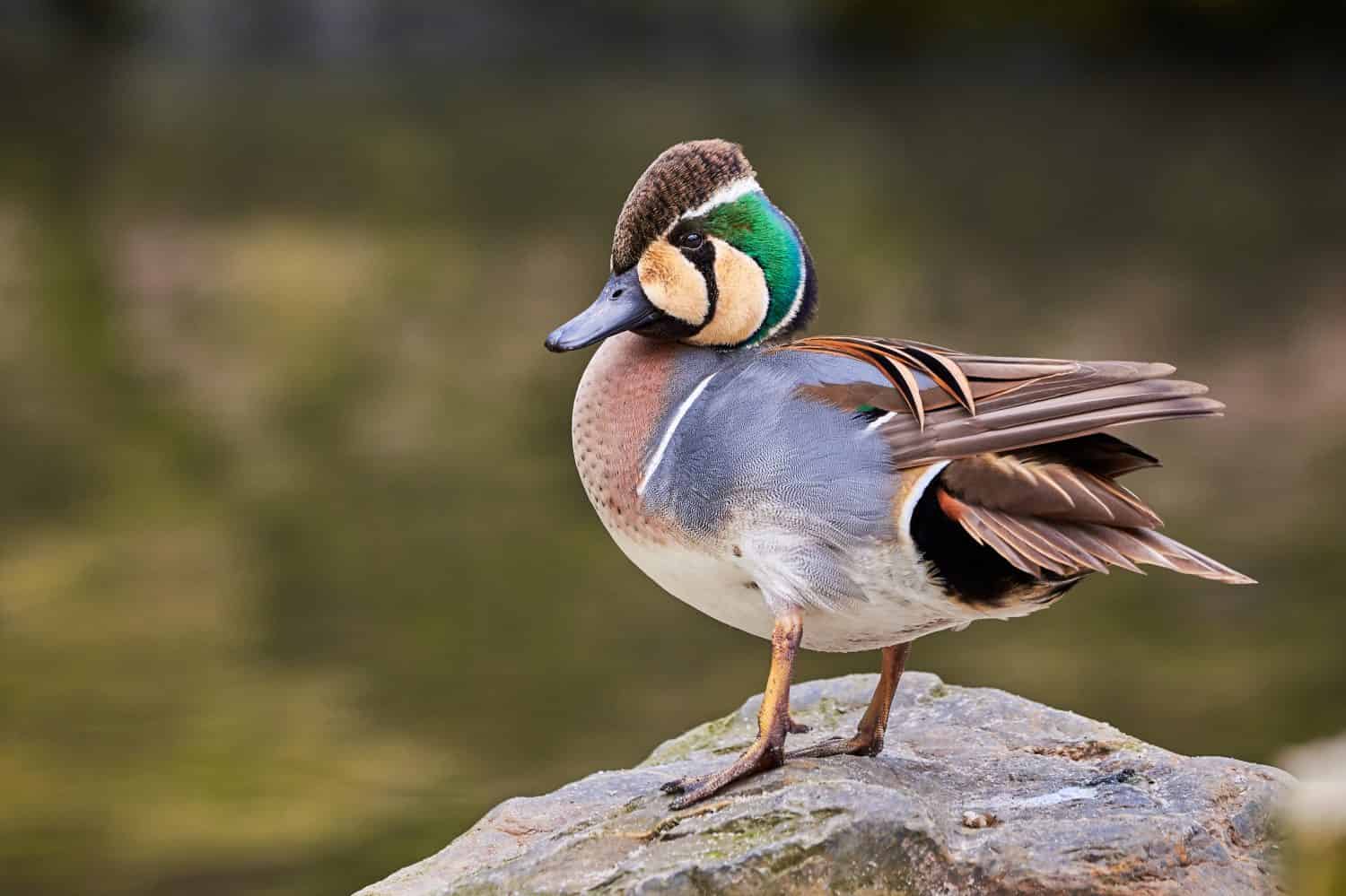
The Baikal teal is a dabbling duck species.
©Adrian Eugen Ciobaniuc/Shutterstock.com
Baikal teals are native to East Asia. The breeding season male has a multicolored head with green, yellow, dark brown, black, and white markings; brown upperparts with rufous and white fringes; spotted pinkish breast; gray flanks; and a white belly. It also has a dark gray bill, brown eyes, and gray to yellowish legs and feet.
3. Bufflehead (Bucephala albeola)

The bufflehead is a diving duck species.
©Birdiegal/Shutterstock.com
Buffleheads are native to North America. The breeding season male is mostly black and white, but the black head plumage is glossy with strong multicolored iridescence. It also has a blue-gray bill, dark brown eyes, and pale pinkish legs and feet.
4. Chestnut Teal (Anas castanea)
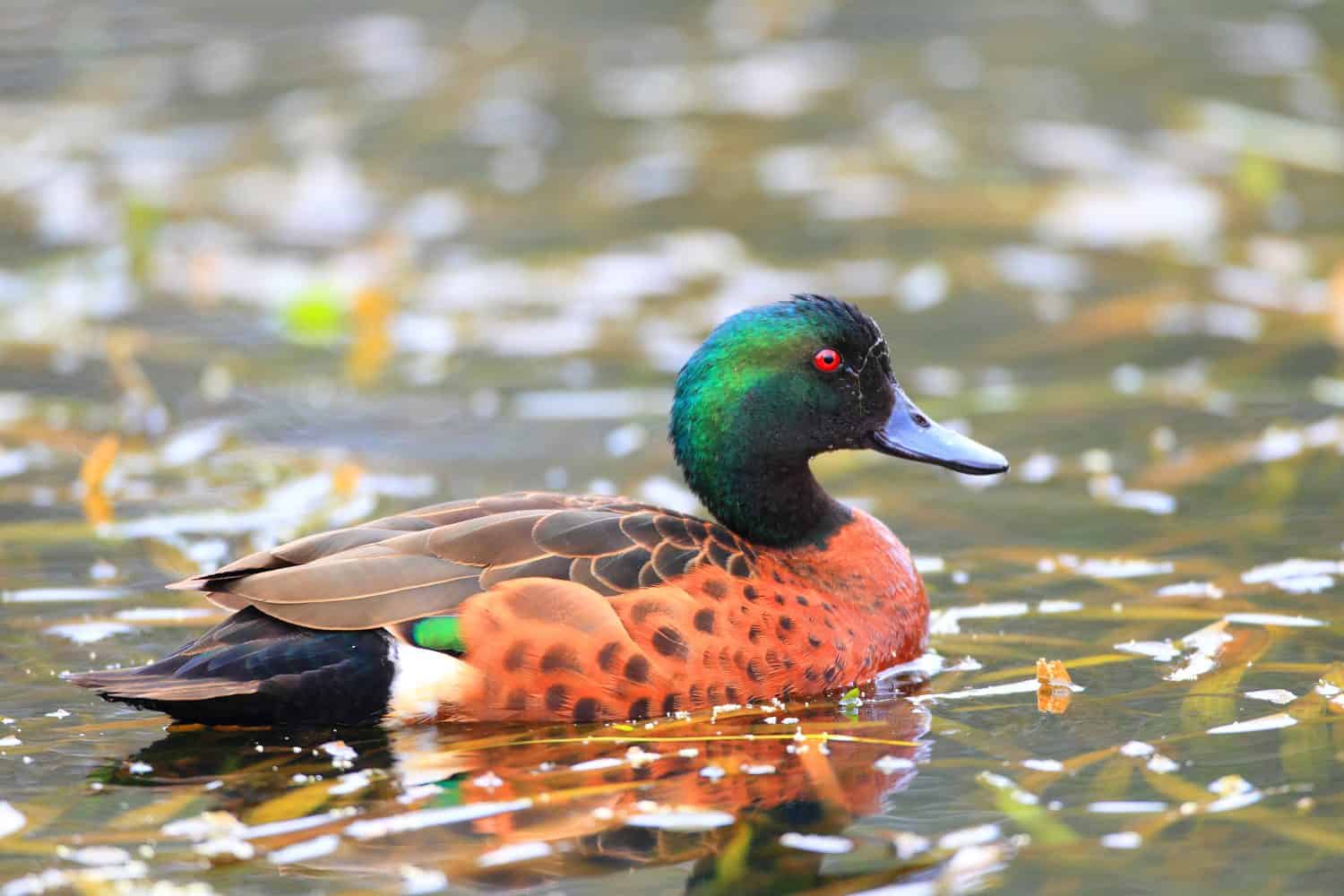
The chestnut teal is a dabbling duck species.
©feathercollector/Shutterstock.com
Chestnut teals are native to mainland Australia and Tasmania. The breeding male has an iridescent green head; dark brown back; black rump and tail, chestnut breast and flanks; and brown, black, and white wing plumage with a small bronze-green patch. It also has a blue-gray bill, bright red eyes, and gray legs and feet.
5. Comb Duck (Sarkidiornis sylvicola)
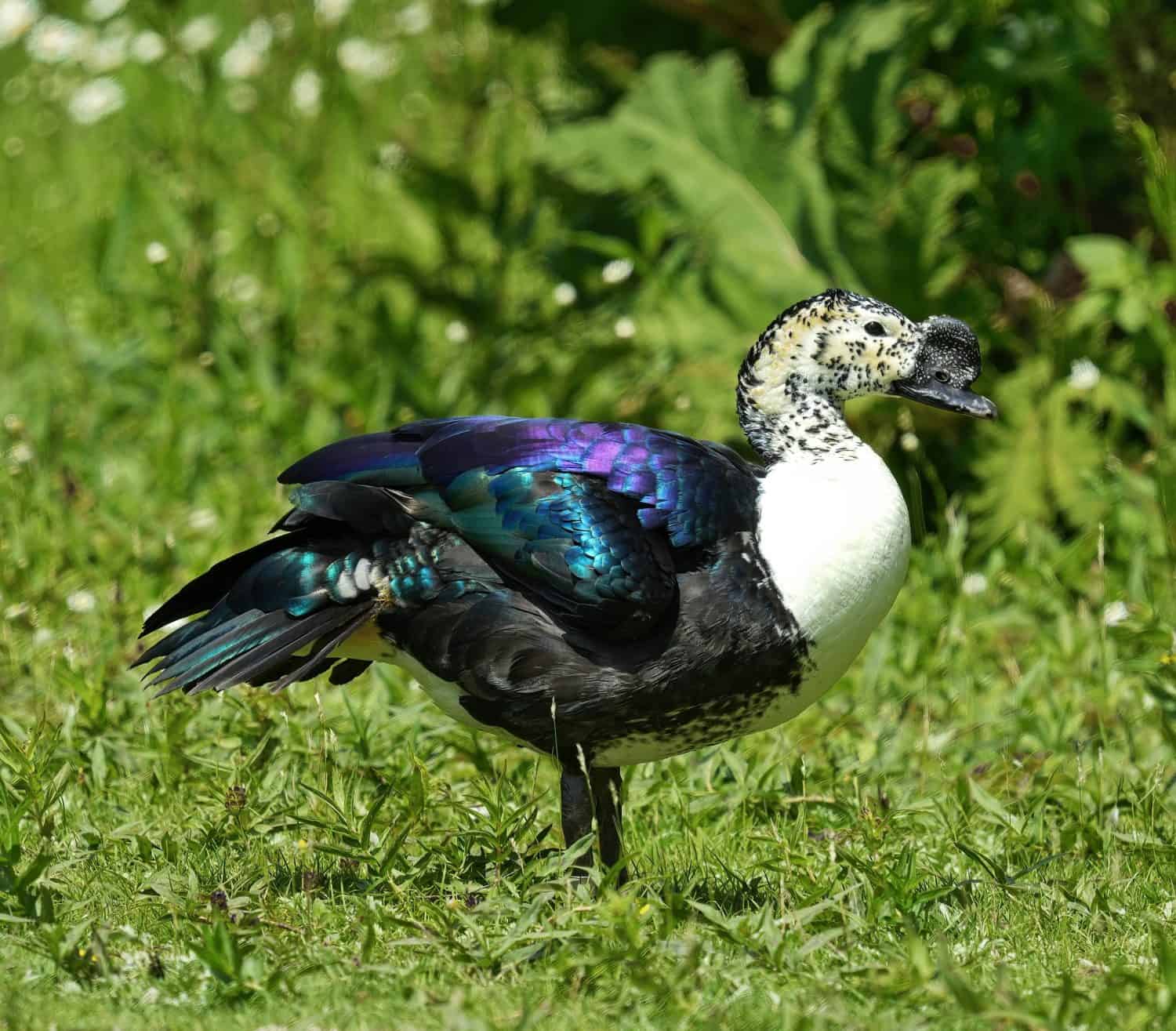
The comb duck is a shelduck species.
©Protean Visuals/Shutterstock.com
Comb ducks are native to South America. The breeding season male has mostly black and white plumage but the upperparts are strongly iridescent with metallic green, blue, and purple sheen. It also has a black bill with large knob, brown eyes, and dark gray legs.
6. Falcated Duck (Mareca falcata)
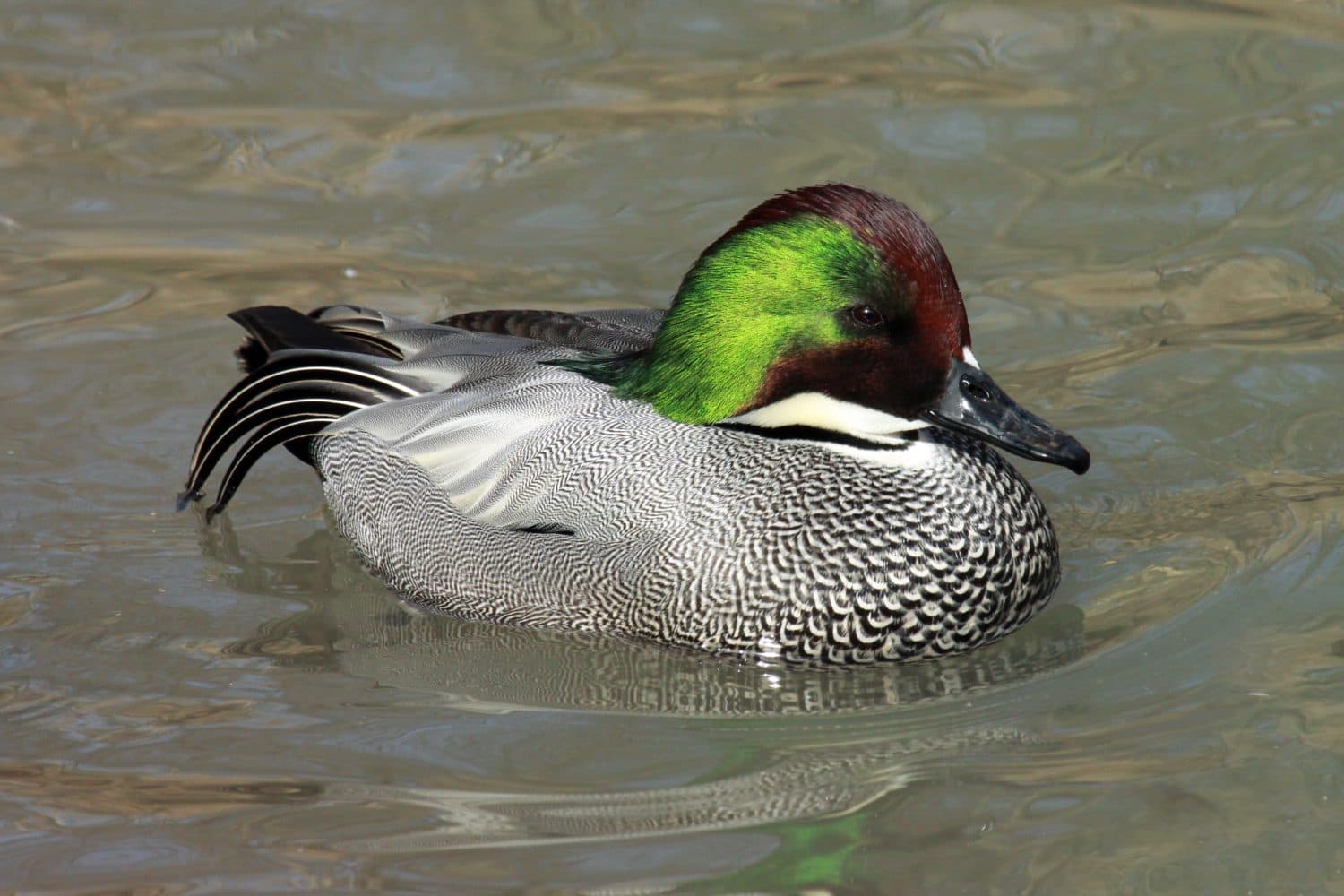
The falcated duck is a dabbling duck species.
©Michal Sloviak/Shutterstock.com
Falcated ducks are native to parts of East, Southeast, and South Asia. The breeding season male has an iridescent head with a metallic purple-chestnut crown and face and metallic green sides, along with intricately patterned body plumage of silvery gray, black, and white. It also has a black bill, brown eyes, and yellowish to bluish-gray legs and feet.
7. Harlequin Duck (Histrionicus histrionicus)
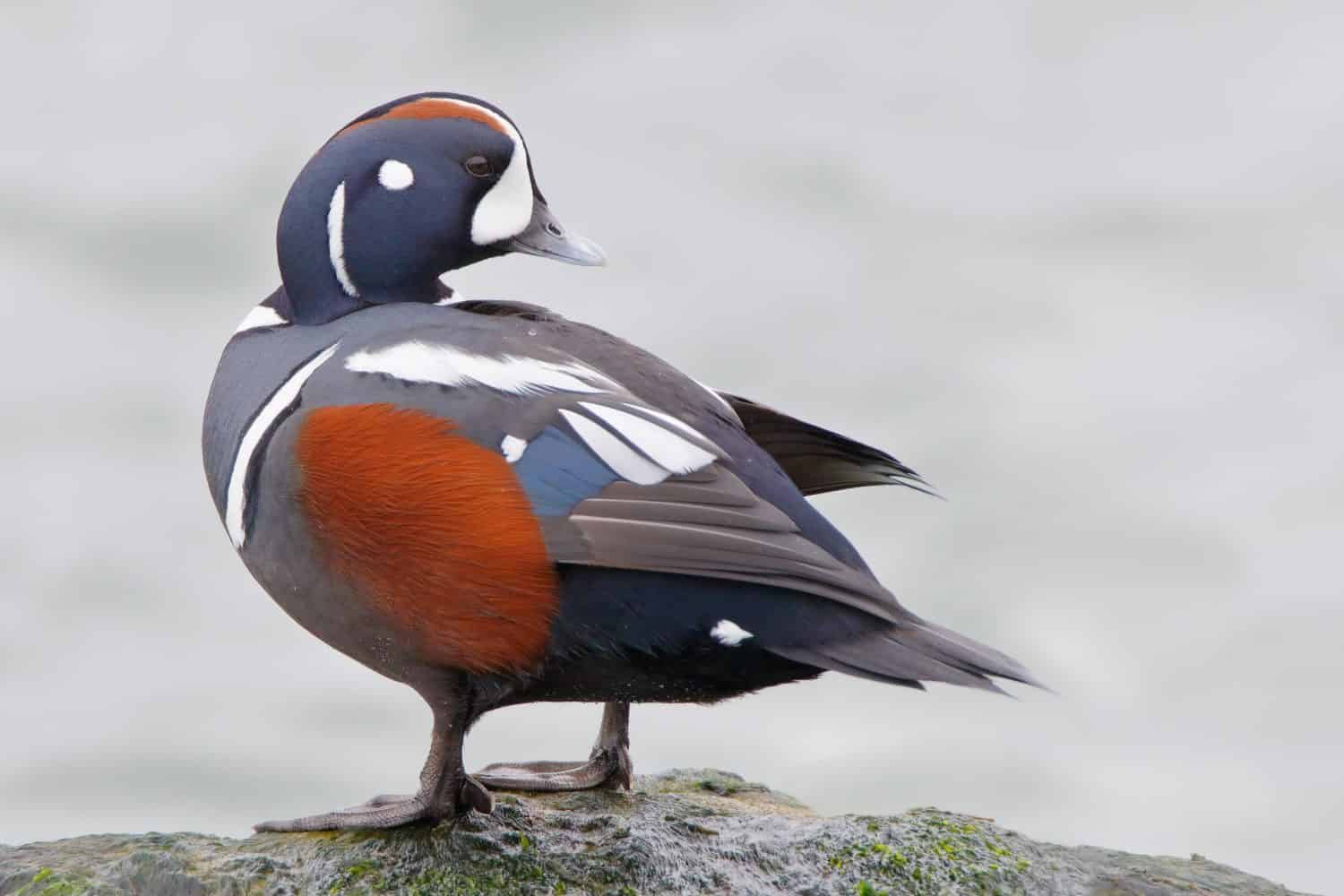
The harlequin duck is a sea duck species.
©Wilfred Marissen/Shutterstock.com
Harlequin ducks are native to both northwestern and northeastern North America and northeastern Asia, where they usually breed in inland streams and winter along the Atlantic and Pacific coasts. The breeding season male has a patchwork plumage of deep slate blue, gray, white, and black. It also has a blue-gray bill, dark reddish-brown eyes, and grayish legs and feet.
8. King Eider (Somateria spectabilis)

The king eider is a sea duck species.
©Heikki Huhtinen/Shutterstock.com
King eiders have a circumpolar distribution, breeding in the high Arctic and wintering in Arctic and Subarctic marine areas. The breeding season male has a head of pearl blue and iridescent pale green patches separated by narrow black and white lines; a buff to salmon colored breast; and black and white plumage throughout the rest of the body. It also has a scarlet bill with a bright yellow frontal lobe outlined in black, black eyes, and yellow legs and feet.
9. Knob-Billed Duck (Sarkidiornis melanotos)
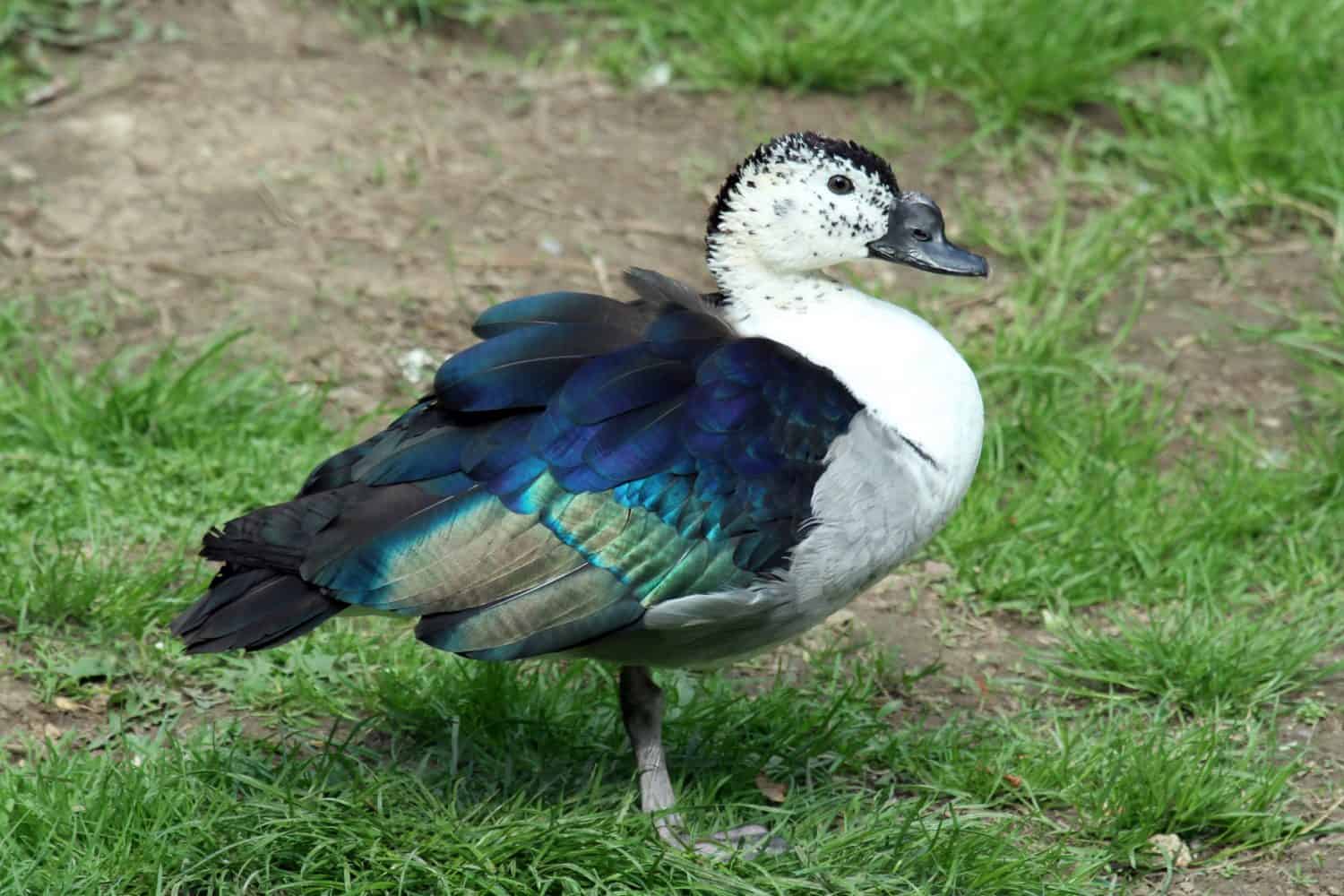
The knob-billed duck is a shelduck species.
©281753982/Shutterstock.com
Knob-billed ducks are native to Sub-Saharan Africa, Madagascar, South Asia, and mainland Southeast Asia. The breeding season male is nearly identicial to its close relative the comb duck (see #5), sporting similar mostly black and white plumage with upperparts strongly iridescent with a metallic green, blue, and purple sheen; however, this species also has some silver gray plumage on its sides. It also has a black bill with large knob, brown eyes, and dark gray legs.
10. Mallard (Anas platyrhynchos)

The mallard is a dabbling duck species.
©Maciej Olszewski/Shutterstock.com
Mallards are widely distributed across the Northern Hemisphere (and have been widely introduced to parts of the Southern Hemisphere including Australia, New Zealand, and South Africa). The breeding season male has a metallic green head with white neck ring, along with body and wing plumage of primarily browns, grays, black, and white, with an iridescent blue to violet-blue wing patch. It also has a yellow to olive bill, dark brown eyes, and orange-red legs and feet.
11. Mandarin Duck (Aix galericulata)

The Mandarin duck is a perching duck species.
©Rob Atherton/iStock via Getty Images
Mandarin ducks are native to East Asia. The breeding season male is often cited as the most colorful of all wild ducks. Along with the distinct orange wing sails and whiskers, it has an ornate plumage patchwork of glossy greens, purples, blues, browns, and black and white. It also has a red bill with pinkish nail, dark brown eyes, and orange-buff legs and feet.
12. Muscovy Duck (Cairina moschata)

The Muscovy duck is a dabbling duck species.
©Jenn Diaz/Shutterstock.com
Muscovy ducks are native to Mexico, Central America, and South America, with feral populations scattered across the United States, Europe, Australia, and New Zealand. The breeding season male has primarily black plumage glossed with a strong green iridescent sheen, along with white wing patches. It also has bare skin on the face that is black with red or pink colored caruncles; a multicolored black, white, and pink bill; brown eyes; and black legs and feet.
13. Northern Shoveler (Spatula clypeata)
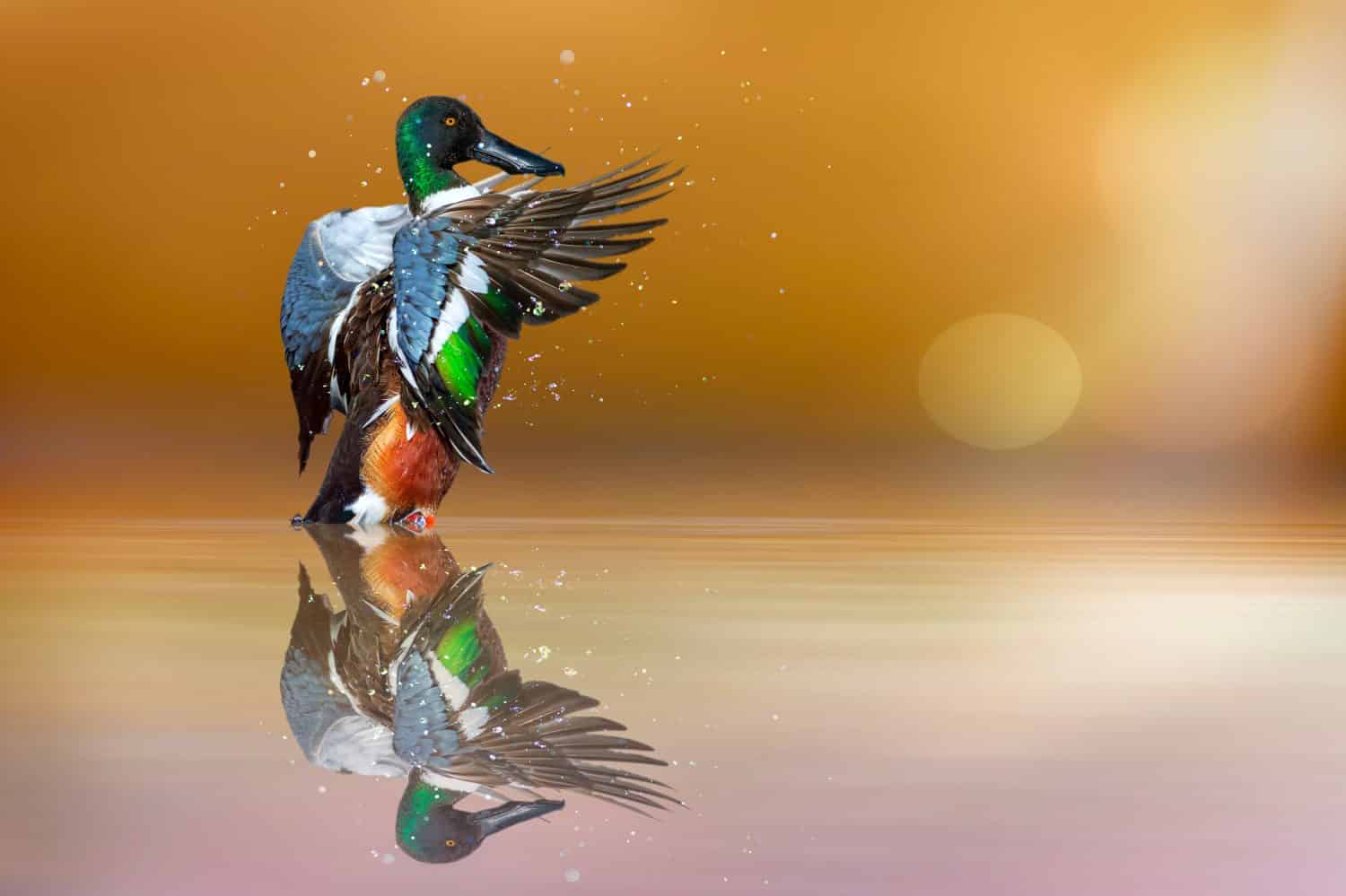
The northern shoveler is a dabbling duck species.
©smutan/Shutterstock.com
Northern shovelers are widely distributed across the Northern Hemisphere. The breeding season male has a dark green iridescent head; bold white, chestnut, and black body plumage; and wings that flash both blue upper wing and green speculum patches when in flight. It also has a black bill, bright yellow eyes, and orange legs and feet.
14. Ruddy Duck (Oxyura jamaicensis)
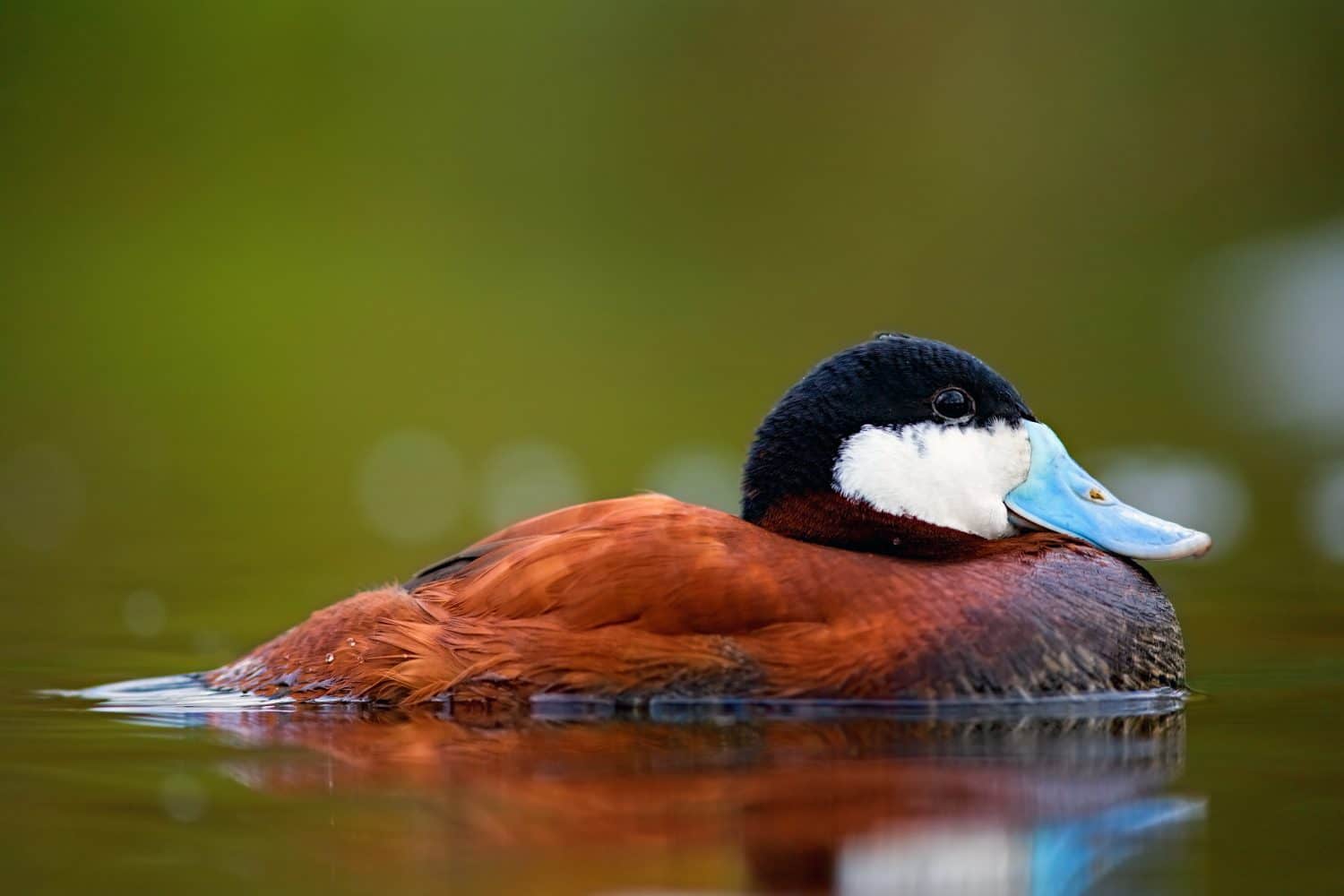
The ruddy duck is a diving duck species.
©Tomatito/Shutterstock.com
Ruddy ducks are native to North America. The breeding season male has a black and white head; bright reddish-chestnut upperparts; silvery-white underparts; and dark brown wings and tail. It also has a beautiful sky-bill blue with blackish nail, reddish-brown eyes, and slaty blue-gray legs and feet.
15. Wood Duck (Aix sponsa)
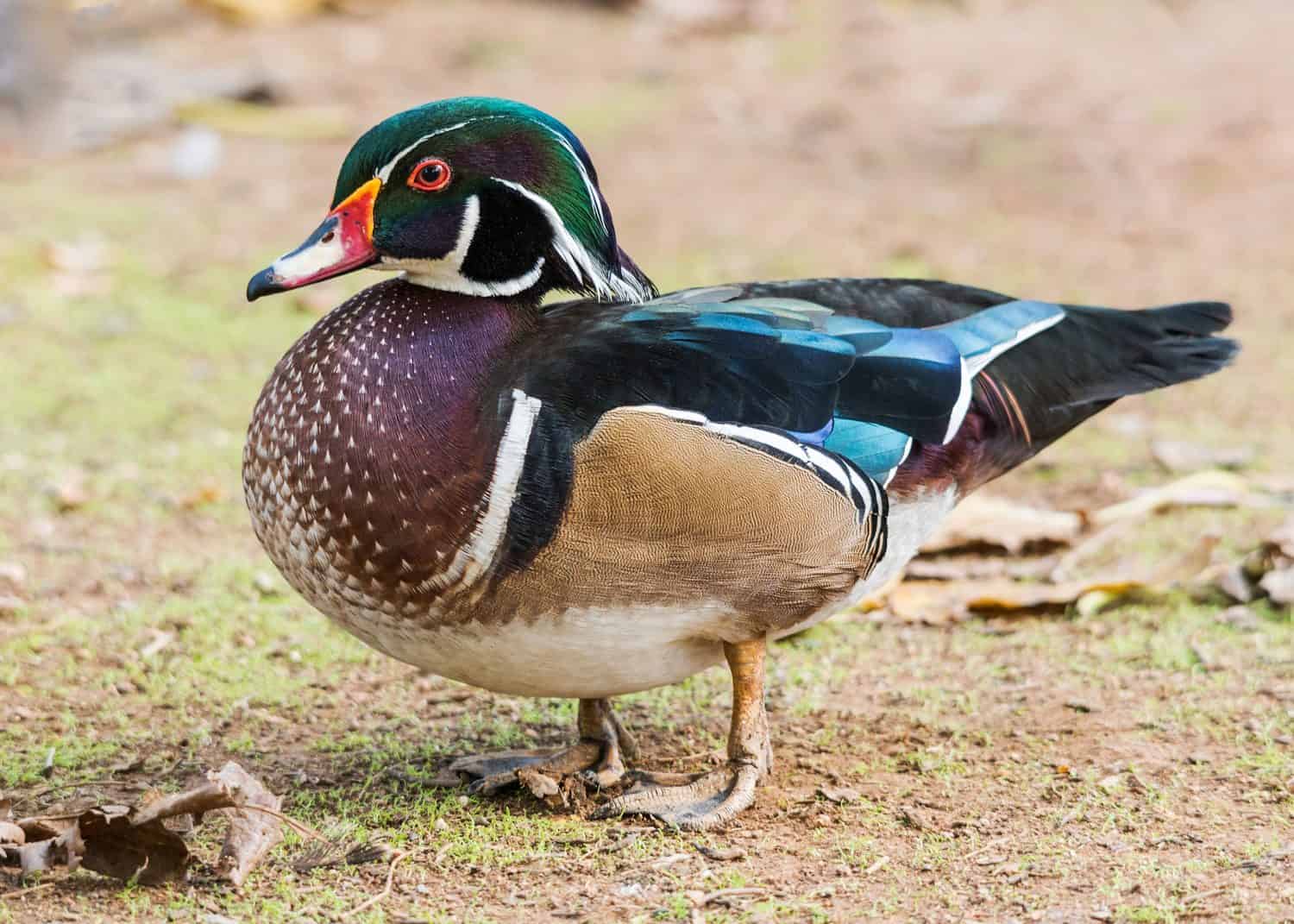
The wood duck is a perching duck species.
©YK/Shutterstock.com
Wood ducks are native to North America and are the most colorful wild ducks in their range. The breeding season male has a crested head with iridescent green and purple marked with white stripes; black upperparts and tail with metallic sheen; multicolored wings with black, white, gray, and various blues; chestnut breast speckled with white; buff sides; and white underparts. It also has a multicolored scarlet, yellow, white, and black bill; red eyes; and yellowish legs and feet.
Summary of Discover the 15 Most Colorful Wild Ducks and Where You Can See Them
| Species | Native Range |
|---|---|
| 1. African Pgymy-Goose (Nettapus auritus) | continental Africa & Madagascar |
| 2. Baikal Teal (Sibirionetta formosa) | East Asia |
| 3. Bufflehead (Bucephala albeola) | North America |
| 4. Chestnut Teal (Anas castanea) | mainland Australia & Tasmania |
| 5. Comb Duck (Sarkidiornis sylvicola) | South America |
| 6. Falcated Duck (Mareca falcata) | East, Southeast, & South Asia |
| 7. Harlequin Duck (Histrionicus histrionicus) | NW & NE North America, NE Asia |
| 8. King Eider (Somateria spectabilis) | Arctic & Subarctic |
| 9. Knob-Billed Duck (Sarkidiornis melanotos) | Sub-Saharan Africa, Madagascar, South Asia, mainland Southeast Asia |
| 10. Mallard (Anas platyrhynchos) | Northern Hemisphere |
| 11. Mandarin Duck (Aix galericulata) | East Asia |
| 12. Muscovy Duck (Cairina moschata) | Mexico, Central America, South America |
| 13. Northern Shoveler (Spatula clypeata) | Northern Hemisphere |
| 14. Ruddy Duck (Oxyura jamaicensis) | North America |
| 15. Wood Duck (Aix sponsa) | North America |
The photo featured at the top of this post is © Christian Musat/Shutterstock.com
Thank you for reading! Have some feedback for us? Contact the AZ Animals editorial team.







